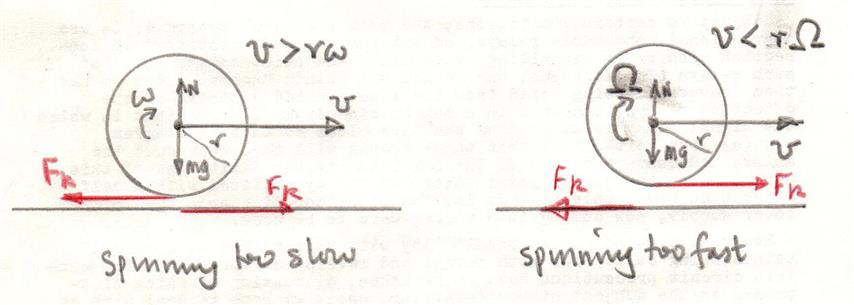The interesting thing is that in the diagram shown above the frictional force is zero so there is no way a frictional force can do any work.
If there was a frictional force acting on rolling object then there would be a torque about its centre of mass and so there would be an angular acceleration.
Also if there was a frictional force acting on the rolling object there would be a net horizontal force acting on it and its centre of mass would undergo a translational acceleration.
Neither of these accelerations happen so there is no frictional force.
In such situation on horizontal surface the only time that there is a kinetic frictional force is when there is slipping at the point of contact. The frictional force will act in such a way as to make the rotating object reach a no slipping situation.
Suppose that the object is not rolling but its centre of mass has a translational velocity. A kinetic frictional force will act in the opposite direction to the translation motion. This frictional force will have two effects.
- Because the frictional force is in the opposite direction to the motion of the object it will reduce the velocity of the centre of mass of the object.
- Because the frictional frictional force is applying a torque about the centre of mass of the object it will make the object rotate.
This continues until $v = r \omega$ the no slipping condition. $v$ is the linear speed of the centre of mass of the object, $r$ is its radius and $\omega$ is the angular speed of the object.
Later
If an external force is applied then what happens next depends on whwere the force is applied.
I such case the external force does work on the rolling object and some of that work is converted into heat because of the work done by a frictional force and the rest increases both the rotational and translational kinetic energies.
Suppose that you have an object rolling (no slipping) along a horizontal surface so $v=r\omega$.
A force $F$ is applied which is parallel to the surface and through the centre of mass of the rolling object.
Assume that in the diagrams above the force acts from left to right.
You now have the rotating too slowly situation.
The net force which produces a translational accelerates of the centre of mass is $F-F_k$ and the torque about the centre of mass which produces the angular acceleration is $F_k r$.
Application of the force at other points are just variations of the description above.

